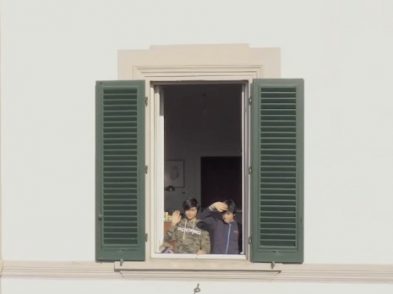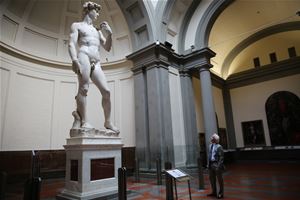Once abandoned, Castelfalfi, an 800-year-old Tuscan village, is being reborn. A German travel company purchased the town and began renovating it, with plans to make it a thriving town and resort. The project, one of the largest such in Europe, promises to bring the village ‘back to life’ by offering visitors an authentic taste of Tuscany. Kirsten Hills visited the site to learn what makes a village authentically Italian or Tuscan.
Castelfalfi is stunning. Perched on a ridge, it overlooks gorgeous countryside. It has everything a visitor expects from a medieval Tuscan village: an eleventh-century castle and church, terracotta rooftops, breathtaking views, Cyprus tress dotting the landscape. Even in November, the light is magical. Castelfalfi is currently being transformed from a ghost town into a thriving upmarket resort. But unlike any other traditional Tuscan village in existence, the apartments will have underfloor heating, wi-fi access, air conditioning, security guards and a bio-mass power generator.
In 2007, Europe’s largest travel group, the Germany-based company TUI, bought the entire village and surrounding 2,700 acres of countryside. TUI is restructuring all 41 properties in the village, three hotels, and 29 villas in the surrounding area and is promising to develop three additional villages nearby. The resulting self-contained resort, expected to be completed in 2014, will have a 36-hole golf course, three swimming pools, tennis courts, at least eight shops, a spa, pizzeria, cookery school and restaurant. The Catholic church will also be asked to revive Sunday services.
Castelfalfi promises views that have been unchanged for 150 years, which means the two modern eyesores in and around the town will be demolished: a large farm building and the film set for Roberto Benigni’s Pinocchio, some of which was shot here.
In its heyday, 500 people lived in Castelfalfi. Their main occupation was growing tobacco and making cigars. But in the late 1950s, the cigar factory closed, and the employees moved to find work elsewhere. The population has dwindled to just two residents in 2007. The former factory will become a boutique hotel.
Previous attempts to revive Castelfalfi have failed, but TUI is confident about the success of the 250 million euro project, even in these financially uncertain times: the developer, TUI says, has the money to complete the project, and while properties aren’t cheap, TUI says that Castelfalfi is generating a lot of interest. One-bedroom apartments will start from 250,000 euro. Maintenance fees will range from 120 to 650 euro per month for security, street cleaning and communal utilities.
Although TUI is targeting British and German buyers, the company is aiming for a goal of one-third of its sales to Italians, in order to retain the ‘authentic Italian’ feel. Wendy Thomson from Knight Frank says there has been a lot of Italian interest, but so far, the 11 properties that have been sold are to non-Italians. ‘Buying in Castelfalfi, takes the hassle out of buying in Tuscany. It is also safer here, with our own security, which really appeals. Property in Tuscany will always hold its value, so we offer a strong investment opportunity.’
But how can a village created for foreigners retain any kind of genuine authenticity? ‘There is a chance this will become a Disneyland version of an Italian village,’ says sociologist Pierluca Birindeli, a professor at Gonzaga University in Florence, ‘but Italy is used to trading on its history and past; we’ve been doing it since the times of The Grand Tour.’
Castelfalfi isn’t the only project of its kind. Its scale is what makes it unique. In Tuscany, Castiglioncello del Trinoro in the Val d’Orca, Castlenuovo dei Sabbioni, Villa Saletta, Castello di Gargonza, and Castelleto Mascagni are just some of the villages that have been redeveloped for a foreign market. ‘It seems ironic that while villages promising an “authentic Italian experience” are thriving, real Italian villages are dying out,’ says Birindeli.
It is a familiar story across Europe: traditional rural life and everything that goes with it threatened as young people move away for work and fewer people pursue careers in farming. In northern Tuscany, Pontito, near Pescia was once a busy village, but now it has just 15 residents. Nearby Vellano has seen the closure of the local school, petrol station, pizzeria and hotel. But these empty properties offer investment opportunities for foreigners in the ever-popular Tuscany. Castelfalfi promises to regenerate an entire area, breathing new life back into a ‘sleeping village’ and creating 250 jobs.
For these reasons the City of Montaioni has supported the project. ‘The citizens have felt all along the development of Castelfalfi represented a good opportunity for the overall development of our territory,’ says Mayor Paola Rossetti. In fact there has been little opposition to the project. WWF and environmental group Legambiente raised concerns about the strain on natural resources like water, but TUI feels it is addressing these issues. Sixty percent of its energy will be created by renewable bio-fuels, and using conditioned rainwater to meet 96 percent of the town’s demand.
While TUI can’t guarantee that Italians will buy (and use) the properties, Thomson says, that with enquiries coming from Australia, South Africa and Russia, ‘Castelfalfi will not be a gated-community, but an international living village.’ ‘We Italians aren’t passive in projects like this. It is not colonisation by the British or Germans, but everyone benefits,’ says Birindeli. ‘The tourists get great food, weather and views, and we Italians get money and other profits from it. So, we are happy.’
For more on Castelfalfi, see www.castelfalfi-resort.com. See project updates at www.tui-group.com.
Castelfalfi by numbers
250 Investment in million euro
250 Jobs expected to be created
2,700 Acres of surrounding area
250,000 euro Property price: one-bedroom apartment
2,5 million euro Property price: restored farmhouse





